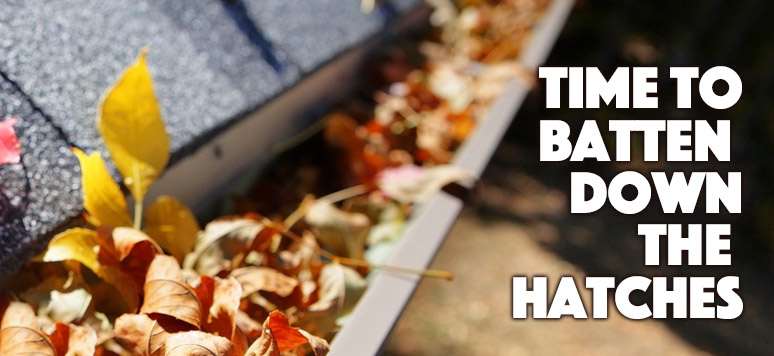Get Prepared for Winter
September 25, 2015 | Filed under: Homeowner Tips,Newsletter Articles,Uncategorized

It has been an absolutely beautiful summer here in Ohio and we hope that the same has been true where you live. While we hate to say good-bye to this season, we’re sure looking forward to the beautiful colors and sights of autumn, as well as those great campfire smells!
Wherever you live, now is the perfect time to check out your roof to make sure it is prepared for winter. Getting out the binoculars and taking a stroll around your home’s perimeter while peering up at the roof can help you decide whether your roof is “good to go” for the winter or if it needs attention. Even in the harshest climates, there are still a few weeks of decent weather left for roof repairs or replacement if necessary.
You can contact us anytime with your questions, concerns, or for a referral to a professional contractor in your area…if your roof inspection brings up a challenge.
Here is a list of things to look for based upon where you live:
In Western states where El Nino threatens…
Loose or broken shingles, tiles, or shakes can quickly become unfortunate points of entry for El Nino rains and winds. Pay close attention for missing hip or ridge shingles, or tiles, as those offer prime spots for weather infiltration.
If there are any areas on your roof where debris such as tree leaves or pine needles have piled up, you want to have those cleaned off. Otherwise, they will become dams which will prevent water from flowing down your roof. And, any time you cause water to back up and pool on your roof, there are sure to be more problems.
In Northern and Central climates with ice and snow…
Areas prone to snow can be prone to ice dams. Last winter was a terrible year for ice dams in the northeast United States. Many of you probably found yourselves getting new roofs this year, in fact. Quality contractors in the New England states are still back logged for many months. In these areas, the best thing you can do is be pro-active. Consider adding insulation to your attic floor and make sure that your attic ventilation is maximized and functioning properly. You need to have an equal balance of intake and exhaust vents. Look also for any sources where warm air from your living space may be leaking into the attic – ceiling can lights are frequent sources for this.
If last winter you had snow sliding too rapidly from your roof, consider adding snow guards to your roof which hold and break up the snow, helping to prevent it from sliding off in one fell swoop. Finally, make sure your gutters are clean so that they do not block water drainage.
In High Altitudes with heavy snow…
High altitudes where snow loads can be very heavy present huge challenges to roofing. Cold temperatures, ice, thawing and re-freezing, sliding snow – all of these impact roofing materials in considerable ways. Inspect your roof to ensure that everything is in place. Clean off any collected debris which otherwise will prevent the snow from sliding. Make sure that your intake soffit vents are clear of insulation and functioning. Try a test in your attic with tissue paper or a smoke pen to make sure that air is flowing correctly. You want your attic to be as cold as possible in the winter. Add insulation on top of your ceilings to keep the heat inside of your home.
If you have any valleys on your roof where snow tends to get jammed up, consider adding snow guards to the roof uphill above the valleys. Snow guards will encourage the snow to stay in place and melt rather than push into the valley where snow from adjoining roof planes becomes a log jam. Move anything around the perimeter of your home inside or further away if it might be broken by avalanching snow loads. If you have heating cables on your roof, check now to make sure they are functioning properly.
In Southern states with heavy rains and winds…
Pelting rain, sand, and salt take their toll on roofing. Check for broken or loose shingles or tiles. Such things must be fixed, or else winter winds will catch them and cause further problems. Look closely at valley and wall flashings to ensure that they are in place and have not degraded over the summer.
The visual check of your roof should not show any missing or cracked shingles or tiles. Make sure, too, that your vents are functioning properly so that they will be in good shape for reducing your attic temperatures next summer.
In Coastal areas with lashing storms…
Even though you may not be in an area that gets much snow or ice, winter weather still brings cooler temperatures as well as greater chance of winds and rains. Cooler temperatures make roof shingles more brittle than normal and increase the chance of roof damages if strong winds come through. And, of course, for many of you, spring will bring increased chance of hail and tornadoes.
Salt climates like yours can be the enemy of the low quality steel that is often used for roof flashings. And, of course, know what your plan is for “battening down the hatches” if hurricane winds threaten your area.
Wherever you live, checking out your home’s roof twice a year is always a good idea. For safety, do your inspection from the ground only, using binoculars if necessary.
Homeowners Associations and Architectural Review Boards
If you live in a neighborhood that has covenants pertaining to roofing, you may want to check out our new website that is designed for Homeowners Associations and Architectural Review Boards. This educational site has been created to help communities consider whether metal roofing is right for homes in their area.
What’s Next?
Enjoy the rest of summer. We will be back in touch in October, enjoying that beautiful autumn season.
Please feel free to call us at 1-800-543-8938 whenever we might be of service. If you have a perplexing or pressing issue pertaining to roofing or ventilation, you can email your questions direct to our company president and roofing guru with 35 years of experience, Todd Miller. His email address is todd@asktoddmiller.com.
